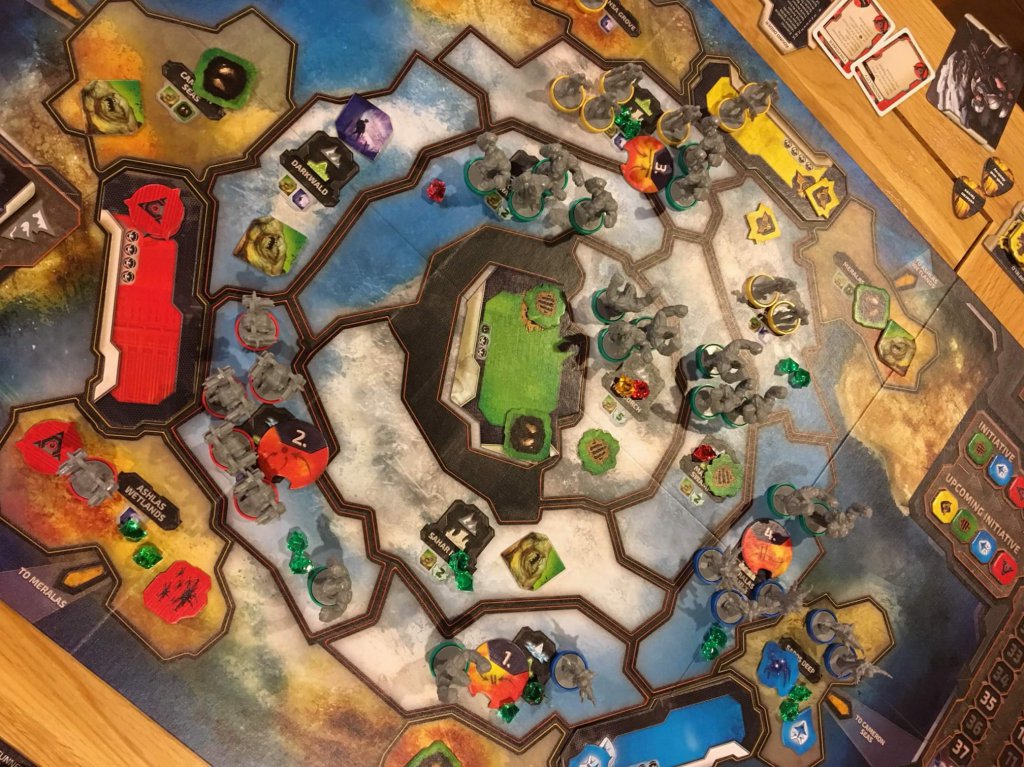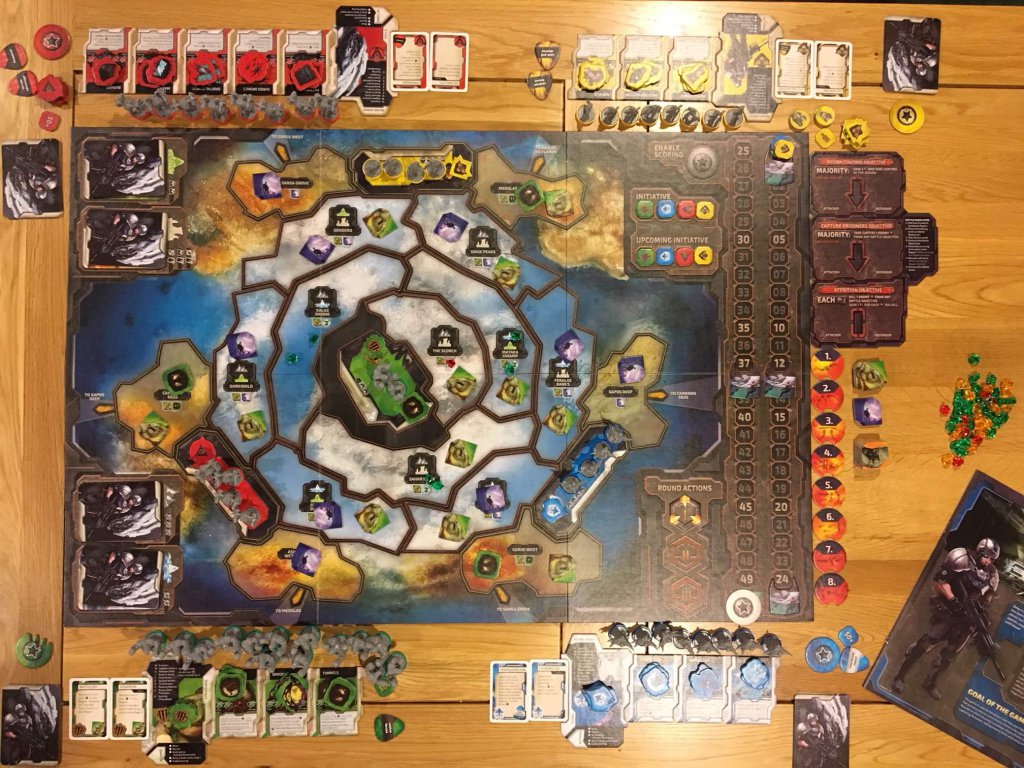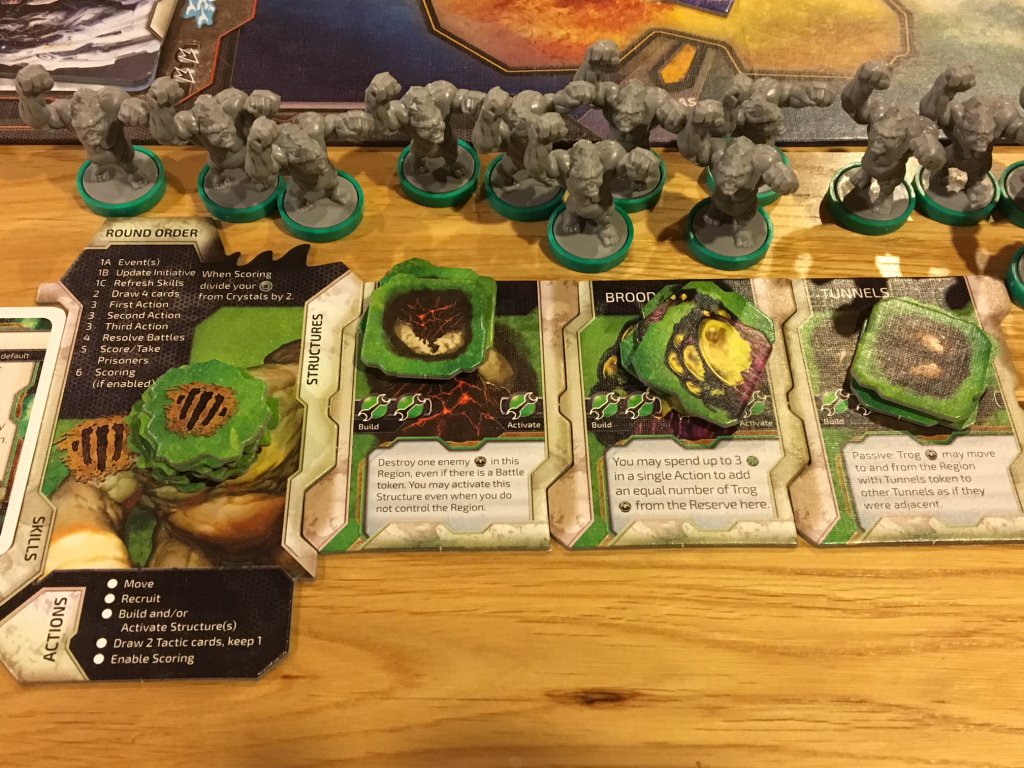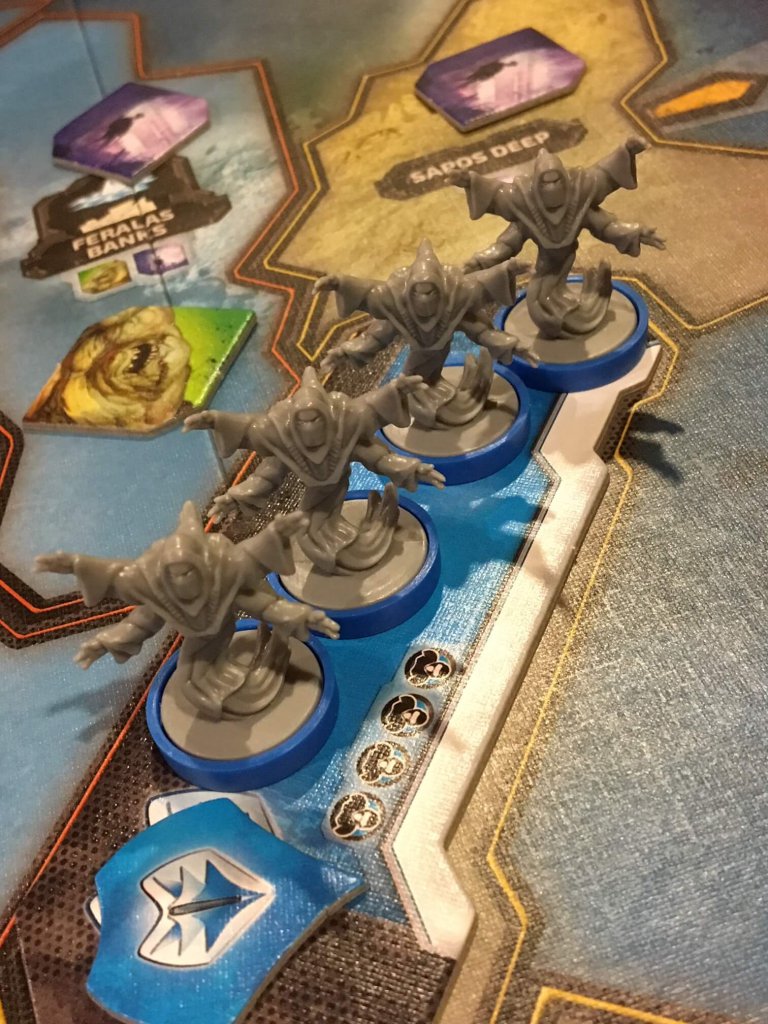Whether you settle on calling it a Dudes on a Map, Area Control or Ameritrash game, Cry Havoc probably fits into all of those (admittedly unnecessary) niches. One of the most surprising hit games of 2016, this big, bold and exceptionally brutal offering from Grant Rodiek and Portal Games replicates the conflict between four very different forces on a distant planet. With tactical gameplay that reminds me of Halo Wars and box art straight out of Crysis, Cry Havoc could be the video gamer’s board game of choice.
After a few decades playing board games, I have long since become immune to the excitement a box of shiny components can conjure up. I do make exceptions though, and Cry Havoc is the case in point. There are lots of figures, player boards, cards and tokens, as well as a gorgeous doubled-sided board that folds out into six leaves. Everything in the box is built to a good standard (without necessarily being exceptional) but what really impressed me was the sheer enthusiasm of it all.
Each of the four factions (Human, Machine, Pilgrim and Trog) is represented by a bright colour scheme which persists through everything from the player boards to the bases that house the actual models. It’s hard to describe in plain text, but Cry Havoc doesn’t just involve punching each other in the game — it literally punches any onlooker with an explosion of colour and excitement. It’s a game with a fairly serious (yet straightforward) set of rules and mechanics to keep it in line, but ultimately almost every turn in Cry Havoc boils down to one thing: shouty men, screeching machines and even shoutier aliens smashing each other’s faces in.

But I’m getting ahead of myself, so let’s get back to basics. Cry Havoc is a game for two, three or four players, but it offers very different experiences at each count. For starters, the two-player game uses one side of the board, whilst three or four player games use the other side. Additionally, no matter how many players are involved, you’ll always have a minimum of three of the four available races on the board. This is because the indigenous race in Cry Havoc (known as the Trogs) is always present, but can only become playable by the last player in a four-player game.
One of the coolest things about Cry Havoc is the asymmetric nature of the races in the game and the variability that can introduce depending on specific touch points between them. The Trogs have the advantage of numbers and tend to flood the board early, but the buildings and skills they have access to tend to be weaker, or at the very least less obviously dangerous. Machines are focused largely on killing enemy units, whilst the reptilian alien race known as The Pilgrims can do unique things with the in-game currency of crystals. The last race — human beings — is fairly handy in a fight, but also has the ability to expand rapidly thanks to their airbase building.
There are no statistics to worry about when it comes to the different races, but there is a huge difference between them. The game is driven by decks of race-specific cards, each of which offers movement, recruitment and building points, as well as some other occasional bonuses like an immediate victory point or the ability to draw more cards. Each player also has access to up to three skill cards (which is set based on player preference at the beginning of the game), then a number of buildings (five for The Machines and three for the other factions). The base decks of cards are somewhat similar, but buildings are distinctly different and it is in them that the true strategic difference between each race shines through.

Each turn is split into three actions, which are taken individually and tracked on the board with a snazzy crosshair token. Players can move, build, recruit, tap a skill card or take one of a few other actions each round. Once all players have taken their three actions, the turn ends and battles are resolved, scoring happens (sometimes) and there are a few cleanup activities to complete. Cry Havoc is card driven, so to move, build or recruit, players discard any number of cards and add up the symbols that represent the action they want to take. For example, if three cards show five movement symbols, that is how many individual moves (with any combination of units, including the same one up to five spaces) can be taken. Similarly, five recruitment points would result in placing up to five new miniatures in your headquarters, whilst five build points would let players build (or activate) structures up to a value of five points.
As far as the way a round pans out, it can often begin with flurries of movement, recruitment and building, but because players only draw their four cards at the beginning of the first round they tend to lose momentum as time goes on. There’s another twist as well, which is that many cards have battle abilities, which confer powerful effects during the battle phase at the end of the turn. Balancing resources in your hand, using buildings, recruiting and knowing when to invade a sector, with how big an army, are all critical to success in Cry Havoc, as is knowing when to use a skill card or enable scoring.
In addition to offering a lot of tactical choice, the board is also very active in Cry Havoc, enticing players to expand rapidly from their starting positions and forcing them into conflict frequently. It is not uncommon for the first round of actions to result in something like four or five individual battles in a four-player game. Every region features one or more tokens or crystals, the latter of which is part of the scoring mechanism within the game. Tokens on the other hand can do various things, with Trog tokens that can reinforce the Trog player (and often bring crystals of their own) and exploration tokens that will sometimes reinforce the faction that discovers them. Exploration tokens also sometimes spawn crystals or allow players to draw from one of four “neutral” card decks which contain additional, region-specific cards.

And this really is where the Area Control (or whatever you’ve settled on) bit comes in. There is a constant push and pull in Cry Havoc, as players struggle to control as many crystals and regions as possible. This is often a simple case of might is right as the armies clash, but the unique abilities of each faction have a fantastic way of driving different behaviour. The Trogs, for example, begin with an abundance of troops, but as the game goes on and their combat advantage declines, they’ll need to use their tunnel buildings to move rapidly from one space to another.
The Machines, on the other hand, revel in combat and have a number of ways to kill their enemies indirectly to increase their advantage during the actual combat phase. Humans expand rapidly and can hold their positions using buildings, whilst The Pilgrims can generate crystals and simply score a ridiculous number of points from them. The only challenge for them is holding onto what they accumulate for long enough to make it count.
When battle is joined (which is frequent) Cry Havoc has an excellent way of resolving it. There are no dice to roll and players simply place the two belligerent forces (the game does not support combat between more than two sides) onto the the battle board, with each miniature placed on one of three objectives: control, take prisoners and attrition. The attacking player places his or her pieces first, then once all pieces are down, players take turns to play cards that specifically relate to battle and may include adding reinforcements or moving those units already in place.

Battle is resolved from the first objective to the last based on majority. So the player with most units in the control objective claims the territory, then prisoners are taken, then units are killed. It’s a remarkably simple system that ensures battles in Cry Havoc remain quick and fun so the number of them never detracts from the focus on collecting crystals and expanding your territory. As if to reinforce that fact, whenever a battle starts an additional crystal is placed in the region, which continually provides an incentive for aggressive, tactical play.
When I look at Cry Havoc as a whole, I’m not surprised that it made such waves when first released. It is a box filled with a lot of high quality components, which makes it excellent on the table, but for all the primary colours and weird alien miniatures, it is also surprisingly tactical. The simple action sequence and innovative battle resolution system are fast and effective, whilst the vast number of crystals and ways to score really capture the imagination. A few nuances such as cards that allow players to change the player order really add the icing to an already impressive cake, which means that I think Cry Havoc has just become my favourite Dudes on a Map game ever!
Comments are closed.